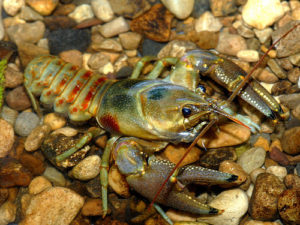
Increase public awareness and understanding of invasive species.ĭevelop and implement innovative technologies that help us to better understand, visualize, alleviate or manage invasive species and their impacts or that serve to strengthen ecosystem function and/or processes. Rusty Crayfish Rusty crayfish have dark rusty-colored spots on each side of their back, about where you would grab them to pick them up. Share resources, including funding personnel, equipment, information, and expertise.Ĭollect, utilize, and share information regarding surveys, infestations, control methods, monitoring, and research.Ĭontrol invasive species infestations by using best management practices, methods and techniques to include: ERADICATION (which is to eliminate all individuals and the seed bank from an area), CONTAINMENT (which is reducing the spread of established infestations from entering an uninfested area) and SUPPRESSION which is to reduce the density but not necessarily the total infested area.ĭevelop and implement effective restoration methods for areas that have been degraded by invasive species and where suppression or control has taken place. Rapidly detect new and recent invaders and eliminate all individuals within a specific area. Prevent the introduction of invasive species into the SLELO PRISM. Rusty crayfish looks similar to native crayfish species but can be identified by more robust claws, and by dark, rusty spots on each side of their carapace (shell). Submerged aquatic plants also provide food and shelter for young gamefish, nesting areas for fish, and erosion control. Their carapace usually has a pair of rusty-colored spots and claws often have black bands at their tips. In turn, this can impact aquatic invertebrates (which provide food for fish and ducks) that rely on submerged aquatic plants for food and cover. The rusty crayfish is a large (up to 6 inches), aggressive species of crayfish which is native to the Ohio River basin. Rusty crayfish can also reduce aquatic plant abundance and species diversity. Therefore, they often displace native crayfish species which are an important food source for fish. First, rusty crayfish are much more aggressive than native crayfish species. The impacts of rusty crayfish are severe and can reverberate through the aquatic food chain. Rusty crayfish are now found in Michigan, Massachusetts, Missouri, Iowa, Minnesota, New Mexico, New York, New Jersey, Pennsylvania, Wisconsin, and all New England states except Rhode Island.

Thought to be native to the Ohio River Basin, the rusty crayfish was likely introduced by anglers who dumped their leftover bait into waterways. Rusty Crayfish (Orconectes rusticus) Rusty crayfish are an aggressive species with the ability to alter the aquatic food chain in non-native ecosystems.


 0 kommentar(er)
0 kommentar(er)
